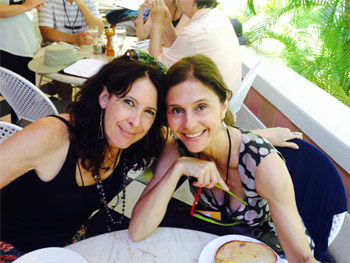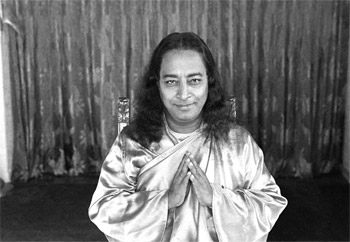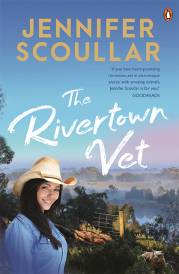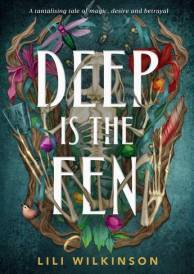Paola di Florio and Lisa Leeman Awake: The Life of Yogananda Interview

Paola di Florio and Lisa Leeman Awake: The Life of Yogananda Interview
Cast: George Harrison, Anupam Kher, Russell Simmons
Directors: Paola di Florio, Lisa Leeman
Genre: Documentary
Rated: PG
Running Time: 87 minutes
Synopsis: Awake: The Life of Yogananda is an unconventional biography about an Indian Swami who brought yoga and meditation to the West in the 1920s. This feature documentary explores the life and teachings of Paramahansa Yogananda, who authored the spiritual classic Autobiography of a Yogi, which has sold millions of copies worldwide and is a go-to book for seekers, philosophers and yoga enthusiasts today. It was the only book that Steve Jobs had on his iPad, and he arranged to give away 800 copies of it to the dignitaries who attended his memorial service. It was also a point of entry into Eastern mysticism for George Harrison, Russell Simmons and countless yogis. By personalizing his own quest for enlightenment and sharing his struggles along the path, Yogananda made ancient teachings accessible to a modern audience, attracting many followers and ultimately helping millions of seekers today to turn their attention inwards, bucking the temptations of the material world in pursuit of self-realization.
Filmed over three years with the participation of 30 countries around the world, the film examines the world of yoga, modern and ancient, East and West. While archival material from the life of Yogananda (who died in 1952) creates a spine for the narrative, the film stretches the dimensions of a standard biography. Footage includes stylized interviews, metaphoric imagery and recreations, taking us from holy pilgrimages in India to Harvard's Divinity School and its cutting-edge physics labs, from the Center for Science and Spirituality at the University of Pennsylvania to the Chopra Center in Carlsbad, California.
By evoking the journey of the soul as it pushes its way through the oppression of the ego and delusion of the material world, the film creates an experiential immersion into the unseen realms. AWAKE is ultimately the story of mankind itself: the universal struggle of all beings to free themselves from suffering and to seek lasting happiness.
Awake: The Life of Yogananda
Directors' Statements
Paola di Florio: 'You should know that I have trouble with the word God," was one of the first things that came out of my mouth in an early meeting with Yogananda's organization, Self Realization Fellowship. I was sitting with my husband / producer Peter Rader, and co-director, Lisa Leeman, facing a team which included senior monks who had spent the better part of four decades in the ashram, renouncing worldly desires in search for the Divine. And they were completely unfazed. More than mere relief, I became intrigued. I later realized that Yogananda's teachings do not require an act of faith or even a belief in God. Yoga is considered a science in India. 'God" is boundless, pure consciousness – 'Satchitananda", which one experiences in meditation. It is not outside oneself but within and all around us. One needs merely to be open and disciplined enough to engage in practice, using one's own body as a living laboratory. I was fascinated with this approach. Not only was I curious to research this for myself, but I saw how brilliant and timely an ecumenical path to transcendence could be in a world where we are killing one another over dogmatic beliefs. A film like AWAKE suddenly felt urgent to me. I was interested in finding meaning at the place where science and spirituality converge.
I had been privy to the transformational effects of this path from a practice of Hatha Yoga, which I began in my 20s. In doing asanas, I experienced my nervous system getting rebooted and my heart opening, which eventually led me to wanting to go deeper by learning how to meditate. I initially took up a Buddhist practice called Vipassana, but while working on AWAKE, I committed to daily meditation.
Initially it was part of my 'research," or so I told myself. But what happened to me was nothing short of total transformation. Essentially, the beauty of yoga is that it meets you where you are. This can happen both on an individual level but also collectively, on a societal level. When Yogananda arrived in America in 1920, newfound Quantum Physics was telling us that matter was elusive – something akin to the notion of 'Maya" from the Vedic teachings of India. It seemed that modern science was finally catching up with the ancient yogis of the Indus Valley. And it couldn't have come a moment too soon. Given the destructive potential of the Atomic age, Yogananda realized it was high time for the masses to embrace these teachings of brotherhood and understanding… how we all emerge from a common ocean of consciousness. The more I read Yogananda's writings, the more I knew I needed to make this film. And, in doing so, the lines between science and spirituality began to blur.
 Lisa Leeman: In 1984, a boyfriend gave me a copy of the Autobiography of a Yogi, saying 'You're too empirical, Lisa…. read this!" He was right - the book exploded my rational mind. I didn't know what to make of Yogananda's stories of yogis levitating, his guru being in two places at once, or Yogananda seeing into the future….and not in my wildest dreams would I have imagined making a film about the author!
Lisa Leeman: In 1984, a boyfriend gave me a copy of the Autobiography of a Yogi, saying 'You're too empirical, Lisa…. read this!" He was right - the book exploded my rational mind. I didn't know what to make of Yogananda's stories of yogis levitating, his guru being in two places at once, or Yogananda seeing into the future….and not in my wildest dreams would I have imagined making a film about the author! I'd always been a seeker – in college I devoured Alan Watts and Zen classics (not knowing that the Tibetan Buddhist master Chogyam Trungpa was only 45 minutes away, in Boulder, or that decades later I'd produce a documentary about him). I took up Hatha Yoga, started meditating, and began making documentary films. One thing led to another, and I found myself in India, as dramaturg on a film about ascetic yogis. A few years later, when Paola invited me to co-direct this film with her, I was intrigued to explore more deeply how a biography of a meditation master could convey Eastern teachings in a visceral, cinematic way, reaching beyond intellect to create an experiential film – to become more than biography.
This film was challenging to make, both cinematically and personally. It forced me to grapple with some of the -big questions' in life, which I've danced around for years. It stretched my notion of yoga (pun intended), deepened my meditation practice, taught me to see past external forms, and expanded my understanding of the nature of reality. I'm still wrestling with the fantastical stories….and I've learned to feel that's ok. As one of the monks in the film said while filming in Calcutta – 'Too often people seek -spiritual experiences' …when what's really important is to cultivate an experience of spirit." I leave it to audiences to interpret what that means for them.
Interview with Paola di Florio and Lisa Leeman
Question: How did your film come to be?
Paola di Florio and Lisa Leeman: Yogananda's legacy organization, Self Realization Fellowship, had been approached for decades by people wanting to make a film about the Guru who brought Yoga to the West. For one reason or another, the time never was right. In 2008, however, an opportunity presented itself with financing through anonymous donors. Yogananda's direct disciples were passing on and it seemed the right moment to make a film. SRF decided to find a team of independent filmmakers to allow for an outside point of view and 'beginner's mind" in telling the story. It was SRF's wish to make a movie for the world and not just for insiders. They did an extensive search and we were fortunate to have been selected to make the film. Of course, right after being hired, we looked at one another and realized we had a daunting task before us! Not only was it an epic story, but it would also challenge us, the filmmakers, to distill these ancient teachings in a user-friendly form for uninitiated audiences. Luckily, we didn't fully realize the extent of the responsibility, because it would have been way too intimidating.
Question: What was the most challenging thing about making this film?
Paola di Florio and Lisa Leeman: There were a lot of challenges! It's not easy to make a film about a saint. We're storytellers, and good narrative usually requires conflict, struggle, and a protagonist with human flaws. We searched for skeletons in Yogananda's -closet,' and while we found certain provocative allegations along the way, there was nothing to back them up. As we dug deeper into his life, however, we discovered that he faced major obstacles, many of which the public was unaware. The quintessential 'fish out of water," Yogananda came to the strange land of America in 1920 to disseminate an ancient teaching that had parallels to the Einsteinian physics of the times. Indeed, these yoga meditation teachings would be seen as essential tools for human beings to survive the atomic age. Despite being recognized as a 'spiritual genius," Yogananda would face severe criticism and even racism in the deep South, from those who felt threatened by him and his message. Persecution, betrayals by students and close friends, and even financial ruin ensued. He was continuously tested. But Yogananda rose like a Phoenix through the ashes of his demise, not only to regain his own purpose in life, but to inspire others to do the same through his example. There were times, however, when Yogananda wanted to run off and be a hermit in a Himalayan cave…which is how we felt sometimes as we approached the challenge of digging through hundreds of files and reels of archival material, and studying the voluminous spiritual teachings Yogananda left behind, distilling them to something understandable (first to us, and then to an audience). At times, we downright wrestled with it. It took us quite awhile to digest and internalize these concepts, and to figure out how to convey them in a cinematic way. We experimented with creating internal states of consciousness through cinematic metaphor, as it was of utmost importance to us that the film be experiential, not merely informational, and that we invite viewers on a journey of deeper awareness and possibility through the filmmaking We decided to have Yogananda tell his story through his own words (rather than using a third person narrator), in an effort to create more intimacy. This meant that, in addition to using some audio recordings of Yogananda, we had the privilege of casting a brilliant, prominent Bollywood star, Anupam Kher, to read his words and essentially 'act the part." This also helped to keep alive a sense of magical realism that Yogananda created when writing Autobiography of a Yogi, where he recounted intimate moments of a life that is well beyond the mundane. We also created measured pacing in moments where viewers could come in and out of 'cinematic meditations," freeing them to disengage from the intellect and allowing them just to 'be."
Question: What do you think audiences will appreciate about your film?
Paola di Florio and Lisa Leeman: We hope the film will place Yogananda in the context of his times, allowing for greater understanding of the history of Yoga in America and what this practice is really all about. But most importantly, we wish for the film to meet people 'where they are at" on their own individual spiritual journeys, and perhaps help plant a seed to take them even deeper. We want to inspire viewers to become AWAKE.
Question: What type of experience do you hope the film will bring to viewers?
Paola di Florio and Lisa Leeman: Yogananda frequently used the ocean as a metaphor for consciousness, a concept people who spend a lot of time in the water seem to realize intuitively. We use a lot of water imagery in the film. Yogananda compared the individual self to waves of the ocean, which take form, and then merge back with the one field that unites us all, the ocean of consciousness.
Awake: The Life of Yogananda
Release Date: July 2nd, 2015
MORE





